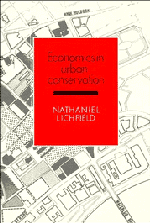Book contents
- Frontmatter
- Contents
- List of diagrams, tables and plans
- Preface
- Acknowledgements
- Introduction
- Part I Planning and management in the conservation of the urban system
- Part II Conservation of the cultural built heritage
- Part III Economics in urban conservation
- Part IV Selected tools of economic analysis for project evaluation
- Part V Case studies in the economics of conservation of the CBH
- Notes
- Bibliography
- Index
Part V - Case studies in the economics of conservation of the CBH
Published online by Cambridge University Press: 10 November 2010
- Frontmatter
- Contents
- List of diagrams, tables and plans
- Preface
- Acknowledgements
- Introduction
- Part I Planning and management in the conservation of the urban system
- Part II Conservation of the cultural built heritage
- Part III Economics in urban conservation
- Part IV Selected tools of economic analysis for project evaluation
- Part V Case studies in the economics of conservation of the CBH
- Notes
- Bibliography
- Index
Summary
Summary
In this part we present a summary of a number of actual cases in the conservation of the CBH, in which the tools of economic analysis described above (Chapters 13–15) have been applied as an aid to reaching decisions on the conservation project.
From amongst the welter of property involving conservation issues, both in plan preparation and also in project development, four have been selected on the following criteria:
(a) well documented, and therefore providing data in the studies;
(b) familiarity with the issues;
(c) illuminating a variety of conservation issues which are of significance for this book, in some logical sequence as follows:
(1) Central Buildings, Southwark, London, a mid-nineteenth-century hop auction market. This shows how financial analysis can be used to test the financial viability of continuing occupation of a historic building while retaining the heritage quality.
(2) Royal Holloway Sanatorium, Surrey, a late nineteenth-century hospital. This starts with a decision that continued occupation for the current use was not viable, so that it would be necessary to adapt the building to a new use. The issue is then how to test through financial analysis the viability of alternative uses that are proposed, in order to show which have the economic potential for sustaining continued life in the building.
[…]
- Type
- Chapter
- Information
- Economics in Urban Conservation , pp. 285 - 288Publisher: Cambridge University PressPrint publication year: 1989



